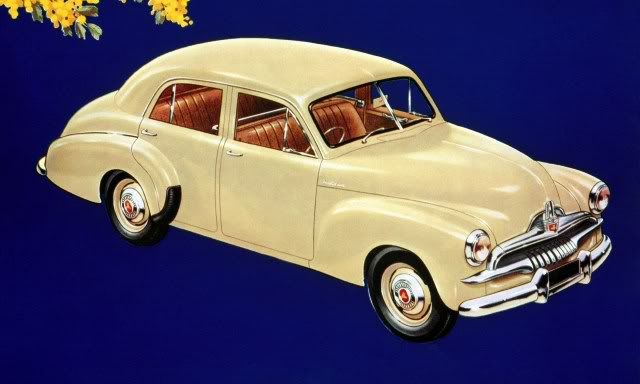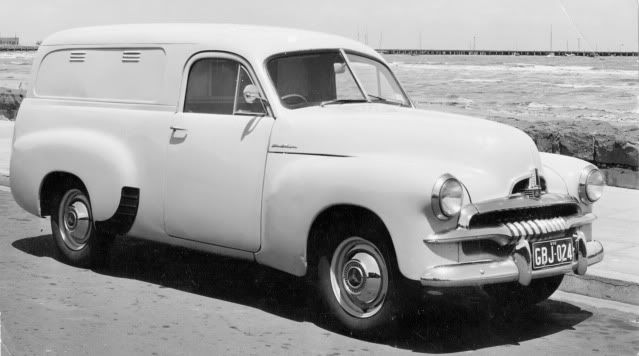The protracted dream of a mass-produced Australian automobile has become reality on October 1, 1948, when the very first Holden 48-215 left the assembly line. The car has enjoyed a tremendous response from the Australian public: this year, Holden has to announce a new expansion plan, setting an annual production of 72,000 vehicles as its newest goal, while updated its car which now becomes the FJ. Holden vehicles are now exported to neighbouring New Zealand.
Holden Standard
Initially launched in November 1948, the very first Australian-made automobile has now evolved into a less spartan FJ model, identified by its new, more elegant grille. More chrome brightens the car on the outside, while the option list is lengthened. Nevertheless, it remains a rugged and simple vehicle, well suited for the task of coping with the hard local conditions.

● Introduction: November 1948 as the 48-215, since October 1953 as the FJ. Construction: unibody. Engine: water-cooled inline six, 2.2-litre, 60 hp, mounted at the front. Transmission: to the rear wheels through a three-speed manual gearbox. Suspension: independent at the front, rigid axle at the rear. Brakes: hydraulic, to drums on all four wheels. Length: 440 cm. Top speed: 130 kph. Range: four-door sedan.
Holden Business
The Business is a simplified version of the FJ, that is mostly aimed at taxicab operators.

● Introduction: November 1948 for the original Holden, July 1953 as the 48-215 Business, since October 1953 as the FJ Business. Construction: unibody. Engine: water-cooled inline six, 2.2-litre, 60 hp, mounted at the front. Transmission: to the rear wheels through a three-speed manual gearbox. Suspension: independent at the front, rigid axle at the rear. Brakes: hydraulic, to drums on all four wheels. Length: 440 cm. Top speed: 130 kph. Range: four-door sedan.
Holden Special
The Special is a new version of the FJ, designed for those Australian drivers who still find the Holden to be too austere. To content them, a host of minor improvements have been added to the car, that is now available with an elegant two-tone paint.
● Introduction: November 1948 for the original Holden, October 1953 as the FJ Special. Construction: unibody. Engine: water-cooled inline six, 2.2-litre, 60 hp, mounted at the front. Transmission: to the rear wheels through a three-speed manual gearbox. Suspension: independent at the front, rigid axle at the rear. Brakes: hydraulic, to drums on all four wheels. Length: 440 cm. Top speed: 130 kph. Range: four-door sedan.
Holden Commercial
The “Utility” or “Ute” pickup is considered a separate series from the FJ. Shortly after the introduction of this newest variant, a panel van is added to the range.

● Introduction: November 1948 for the original Holden, January 1951 as the 50-2106, since October 1953 as the FJ Commercial. Construction: unibody. Engine: water-cooled inline six, 2.2-litre, 60 hp, mounted at the front. Transmission: to the rear wheels through a three-speed manual gearbox. Suspension: independent at the front, rigid axle at the rear. Brakes: hydraulic, to drums on all four wheels. Length: 440 cm. Top speed: 130 kph. Range: two-door “Utility” pickup, two-door panel van (from December 1953).
Any mistake you’ve just spotted? A detail to add? A suggestion? Don’t hesitate to leave a comment!
Click to jump to another model year of the same car: 1949 – 1950 – 1951 – 1952 – 1953 – 1954 – 1955 – 1956
Click here to return to a list of all Holden vehicles presented on this blog.
Click here to return to this blog’s initial post, featuring a list of all vehicles already presented.
Holden Standard
Initially launched in November 1948, the very first Australian-made automobile has now evolved into a less spartan FJ model, identified by its new, more elegant grille. More chrome brightens the car on the outside, while the option list is lengthened. Nevertheless, it remains a rugged and simple vehicle, well suited for the task of coping with the hard local conditions.

● Introduction: November 1948 as the 48-215, since October 1953 as the FJ. Construction: unibody. Engine: water-cooled inline six, 2.2-litre, 60 hp, mounted at the front. Transmission: to the rear wheels through a three-speed manual gearbox. Suspension: independent at the front, rigid axle at the rear. Brakes: hydraulic, to drums on all four wheels. Length: 440 cm. Top speed: 130 kph. Range: four-door sedan.
Holden Business
The Business is a simplified version of the FJ, that is mostly aimed at taxicab operators.

● Introduction: November 1948 for the original Holden, July 1953 as the 48-215 Business, since October 1953 as the FJ Business. Construction: unibody. Engine: water-cooled inline six, 2.2-litre, 60 hp, mounted at the front. Transmission: to the rear wheels through a three-speed manual gearbox. Suspension: independent at the front, rigid axle at the rear. Brakes: hydraulic, to drums on all four wheels. Length: 440 cm. Top speed: 130 kph. Range: four-door sedan.
Holden Special
The Special is a new version of the FJ, designed for those Australian drivers who still find the Holden to be too austere. To content them, a host of minor improvements have been added to the car, that is now available with an elegant two-tone paint.
● Introduction: November 1948 for the original Holden, October 1953 as the FJ Special. Construction: unibody. Engine: water-cooled inline six, 2.2-litre, 60 hp, mounted at the front. Transmission: to the rear wheels through a three-speed manual gearbox. Suspension: independent at the front, rigid axle at the rear. Brakes: hydraulic, to drums on all four wheels. Length: 440 cm. Top speed: 130 kph. Range: four-door sedan.
Holden Commercial
The “Utility” or “Ute” pickup is considered a separate series from the FJ. Shortly after the introduction of this newest variant, a panel van is added to the range.

● Introduction: November 1948 for the original Holden, January 1951 as the 50-2106, since October 1953 as the FJ Commercial. Construction: unibody. Engine: water-cooled inline six, 2.2-litre, 60 hp, mounted at the front. Transmission: to the rear wheels through a three-speed manual gearbox. Suspension: independent at the front, rigid axle at the rear. Brakes: hydraulic, to drums on all four wheels. Length: 440 cm. Top speed: 130 kph. Range: two-door “Utility” pickup, two-door panel van (from December 1953).
Any mistake you’ve just spotted? A detail to add? A suggestion? Don’t hesitate to leave a comment!
Click to jump to another model year of the same car: 1949 – 1950 – 1951 – 1952 – 1953 – 1954 – 1955 – 1956
Click here to return to a list of all Holden vehicles presented on this blog.
Click here to return to this blog’s initial post, featuring a list of all vehicles already presented.
No comments:
Post a Comment